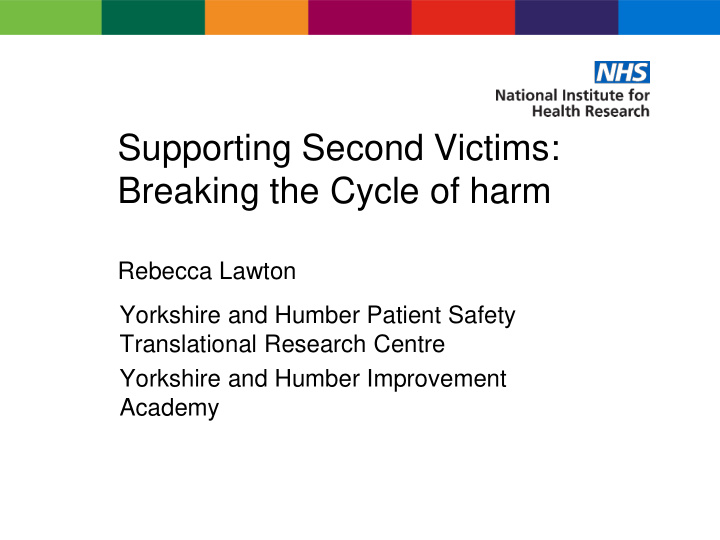



Supporting Second Victims: Breaking the Cycle of harm Rebecca Lawton Yorkshire and Humber Patient Safety Translational Research Centre Yorkshire and Humber Improvement Academy
Improving patient care Outline • The impact of medical error • Findings of a survey of doctors • What can we do to better to support ‘second victims’ • The website Yorkshire and Humber Patient Safety Translational Research Centre
Yorkshire and Humber Patient Safety Translational Research Centre
Emotional consequences Systematic reviews 2 Guilt demonstrate consistent Shame Incompetent effects of making a medical error: Error Lose Depression confidence Anxiety 2 Sirriyeh et al (2010); Seys et al (2013) Yorkshire and Humber Patient Safety Translational Research Centre
Patient Shame, safety guilt, 1,895,834 incidents Does your anxiety incidents organisation reported in treat people England fairly after an 2016-2017, incident – only 10,000 of which 43% of people caused severe Burnout agreed or harm or death. strongly agreed 38% reported work related stress in the last 12 months (up from 29% five years earlier) NRLS Report March 2018
Improving patient care Background to our survey • Term – second victim first coined by Albert Wu • Second victim research predominantly US based (see Wu et al. 2000) • Small scale studies in UK focusing on one or two hospitals • Survey of 11,800 doctors with RCP; 1,755 responded Yorkshire and Humber Patient Safety Translational Research Centre
Improving patient care Yorkshire and Humber Patient Safety Translational Research Centre
Improving patient care Key Findings • 821 of 1637 indicated they had been involved in an adverse event with serious patient harm • 1068 physicians responded yes to the statement: do you believe that involvement in a near miss or adverse event has affected your personal or professional life • Most common consequences: Losing confidence as a doctor and inability to sleep • 119 reported symptoms consistent with PTSD Yorkshire and Humber Patient Safety Translational Research Centre
Improving patient car e Feelings after an adverse event or near miss Yorkshire and Humber Patient Safety Translational Research Centre
Improving patient care Hospitals and healthcare organisations adequately support doctors in dealing with the stress associated with near misses or adverse events Yorkshire and Humber Patient Safety Translational Research Centre
What can organisations do to support second victims? Improving patient care • Support should be offered in the short, medium and long term. A rapid response is necessary • Support from colleagues, supervisors and managers is essential • Additional support (from a specialist) may be required in some cases • Support systems should be part of an integrated patient safety system which involves support for patient, healthcare professional as well as organisational learning • Develop incident investigation processes that support staff and facilitate learning for the team Yorkshire and Humber Patient Safety Translational Research Centre
https://www.youtube.com/watc h?v=M0HxFURKU_Y&feature =youtu.be What three things could an organisation do to support Simon?
Why support second victims? • Morally it is the right thing to do • Impact on ability to perform job (Wu and Steckelberg, 2014) • Turnover (Lander et al., 2007; second victims are more likely to leave service or clinical practice altogether) • In extreme cases, being a second victim can lead to suicide (Hawton, 2015) ‘A recent survey of a large sample of UK doctors subject to complaints procedures indicated that depression, anxiety, and suicidal ideas, together with adverse changes in their clinical practice, were considerably increased compared with doctors not subject to complaints’ • Being a second victim is associated with the practice of defensive medicine (Panella et al., 2016) ‘ The most prominent predictor for practising defensive medicine was the physicians’ experience of being a second victim after an adverse event (OR = 1.88; 95%CI, 1.38 –2.57)’ Yorkshire and Humber Patient Safety Translational Research Centre
What are we doing • Preparing staff for adverse incidents (resilience training) • A second victim website • Next steps – in house support – first aid toolkit Yorkshire and Humber Patient Safety Translational Research Centre
Denham’s 5 rights of second victims T reatment is just R espect U nderstanding and compassion S upportive care T ransparency
Improving patient care References • Wu AW. Medical error: the second victim. BMJ 2000;320:726. • Wu, A. W., & Steckelberg, R. C. (2012). Medical error, incident investigation and the second victim: doing better but feeling worse?. • Sirriyeh R, Lawton RJ, Gardner P et al. Coping with medical error: a systematic review of papers to assess the effects of involvement in medical error on health care professional’s psychological wellbeing. Qual Saf Health Care 2010;19:1 – 8. • Seys D, Scott S, Wu AW et al. Supporting involved health professional (second victims) following an adverse event: a literature review. Int J Nurs Stud 2013;50:678 – 87. • Scott S, Hirschinger L, Cox K et al . Caring for our own: deploying a system wide second victim rapid response team. Jt Comm J Qual Patient Saf 2010;36:233 – 40. • Harrison, R., Lawton, R., & Stewart, K. Doctors’ experiences of adverse events in secondary care: the professional and personal impact. Clinical Medicine 2014; 14 : 585-590. Yorkshire and Humber Patient Safety Translational Research Centre
Recommend
More recommend